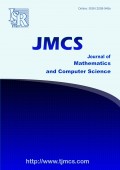Existence and Stability of solution to a fractional mathematical model of the brain metabolite variations in the circadian rhythm containing Caputo derivative
Authors
E. A. A. Ziada
- Basic Science Department, Nile Higher Institute for Engineering and Technology, Mansoura, Egypt.
S. El-Morsy
- Basic Science Department, Nile Higher Institute for Engineering and Technology, Mansoura, Egypt.
- Department of Mathematics, College of Science and Arts, Qassim University, Al- Badaya 51951, Saudi Arabia.
Abstract
This study intends to investigate whether a solution to the model of brain
metabolite variations in the circadian rhythm exists. The model is a
fractional-order important model with regard to applications. The existence
of a unique solution to the fractional brain model (FBM) with Caputo
derivative is demonstrated, and the general form of the model is provided. A
stability analysis is performed on the solution. In four different cases,
the numerical solution to FBM is given using the proposed numerical method.
Share and Cite
ISRP Style
E. A. A. Ziada, S. El-Morsy, Existence and Stability of solution to a fractional mathematical model of the brain metabolite variations in the circadian rhythm containing Caputo derivative, Journal of Mathematics and Computer Science, 39 (2025), no. 3, 348--360
AMA Style
Ziada E. A. A., El-Morsy S., Existence and Stability of solution to a fractional mathematical model of the brain metabolite variations in the circadian rhythm containing Caputo derivative. J Math Comput SCI-JM. (2025); 39(3):348--360
Chicago/Turabian Style
Ziada, E. A. A., El-Morsy, S.. "Existence and Stability of solution to a fractional mathematical model of the brain metabolite variations in the circadian rhythm containing Caputo derivative." Journal of Mathematics and Computer Science, 39, no. 3 (2025): 348--360
Keywords
- Brain metabolites
- fractional mathematical model
- circadian rhythm
- existence and uniqueness
- fractional derivatives
- Caputo derivative
- proposed numerical method
MSC
References
-
[1]
Solving a system of fractional partial differential equations arising in the model of HIV infection of CD4+ cells and attractor one-dimensional Keller-Segel equations, A. Atangana, E. Alabaraoye, Adv. Differ. Equ., 2013 (2013), 14 pages
-
[2]
D. Baleanu, A. Jajarmi, S. S. Sajjadi, D. Mozyrska, A new fractional model and optimal control of a tumor-immune surveillance with non-singular derivative operator, Chaos, 29 (2019), 15 pages
-
[3]
D. Baleanu, P. Shekari, L. Torkzadeh, H. Ranjbar, A. Jajarmi, K. Nouri, Stability analysis and system properties of Nipah virus transmission: a fractional calculus case study, Chaos Solitons Fractals, 166 (2023), 10 pages
-
[4]
R. F. Curtain, A. J. Pritchard, Functional analysis in modern applied mathematics, Academic Press [Harcourt Brace Jovanovich, Publishers], London-New York (1977)
-
[5]
A. Daraghmeh, N. Qatanani, A. Saadeh, Numerical solution of fractional differential equations, Appl. Math., 11 (2020), 16 pages
-
[6]
O. Defterli, D. Baleanu, A. Jajarmi, S. S. Sajjadi, N. Alshaikh, J. H. Asad, Fractional treatment: an accelerated massspring system, Rom. Rep. Phys., 74 (2022), 13 pages
-
[7]
N. Dunford, J. T. Schwartz, Linear operators. Part I, John Wiley & Sons, New York (1988)
-
[8]
A. M. A. El-Sayed, I. L. El-Kalla, E. A. A. Ziada, Analytical and numerical solutions of multi-term nonlinear fractional orders differential equations, Appl. Numer. Math., 60 (2010), 788–797
-
[9]
A. M. A. El-Sayed, H. H. G. Hashem, E. A. A. Ziada, Picard and Adomian decomposition methods for a quadratic integral equation of fractional order, Comput. Appl. Math., 33 (2014), 95–109
-
[10]
A. Fernandez, A complex analysis approach to Atangana-Baleanu fractional calculus, Math. Methods Appl. Sci., 44 (2021), 8070–8087
-
[11]
K. Goebel, W. A. Kirk, Topics in Metric Fixed point theory, Cambridge University Press, Cambridge (1990)
-
[12]
H. A. Hammad, M. De la Sen, Tripled fixed point techniques for solving system of tripled-fractional differential equations, AIMS Math., 6 (2021), 2330–2343
-
[13]
L. Hatchondo, C. Guillevin, M. Naudin, L. Cherfils, A. Miranville, R. Guillevin, Mathematical modeling of brain metabolites variations in the circadian rhythm, AIMS Math., 5 (2020), 216–225
-
[14]
A. A. Kilbas, H. M. Srivastava, J. J. Trujillo, Theory and Applications of Fractional differential equations, Elsevier Science B.V., Amsterdam (2006)
-
[15]
K. S. Miller, B. Ross, An introduction to the fractional calculus and fractional differential equations, John Wiley & Sons, Inc., New York (1993)
-
[16]
I. Podlubny, Fractional differential equations, Academic Press, San Diego (1999)
-
[17]
S. Z. Rida, A. A. M. Arafa, New Method for Solving Linear Fractional Differential Equations, Int. J. Differ. Equ., 2011 (2011), 8 pages
-
[18]
M. I. Syam, M. Al-Refai, Fractional differential equations with Atangana–Baleanu fractional derivative: Analysis and applications, Chaos Solitons Fractals, 2 (2019), 1–5
-
[19]
E. A. A. Ziada, M. Botros, Solution of a fractional mathematical model of brain metabolite variations in the circadian rhythm containing the Caputo–Fabrizio derivative, J. Appl. Math. Comput., (2025), 28 pages
-
[20]
D. Zwillinger, Handbook of differential equations, Academic Press, Boston (1992)

